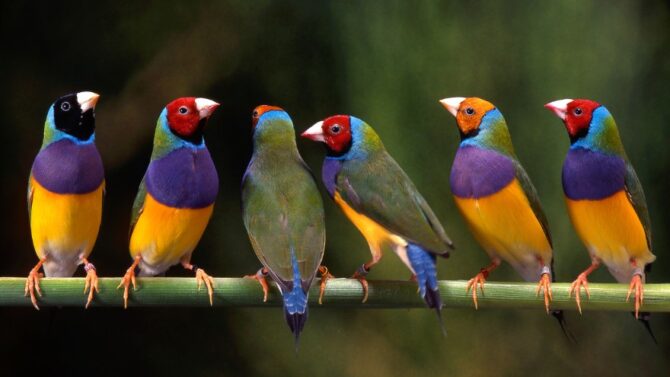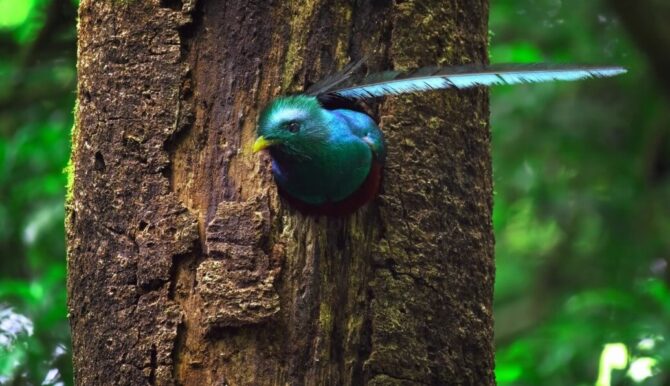There’s something about birds that make us look when they swoop by.
Many bird watchers can attest to how endearing these creatures are, and that’s why they are worth gathering at parks to watch.
Birds come in different forms, and there are some very beautiful bird species because of their colorful plumage.
Examples of colorful tropical birds include the Nicobar pigeon, scarlet ibis, Victoria-crowned pigeon, shining green hummingbird, and long-tailed broadbill, to mention a few.
The following is a list of 20 colorful types of tropical birds in the world, how to identify them, and some interesting facts you probably didn’t know.
The Most Colorful Tropical Birds in the World
Fun Fact: A study involving mathematical color analysis of 4,500 birds from around the world shows that tropical birds are more colorful than temperate species.1 These include species from the Amazon, South Asia, and West Africa.
1. Nicobar Pigeon
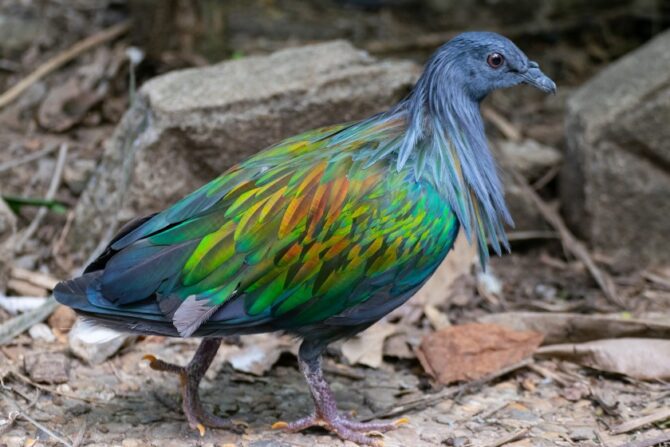
- Scientific Name: Caloenas nicobarica
- Range: Andamar and Nicobar Islands, Malay archipelago, Solomons, Palau
The first on our list of colorful birds is the Nicobar pigeon, a creature found on some small islands.
It is considered the largest living pigeon, and its close relative, the dodo bird, is now extinct. This bird is named after Nicobar Island, one of the places it lives.
The Nicobar pigeon is what you’d expect a normal pigeon to look like, but the coloring makes a major difference.
Unlike the drab nature of pigeons, the Nicobar pigeon is iridescent and eye-catching.
While the plumage itself is a metallic green, it can display other colors like blue, red, and purple when the light’s on them. The head is grey, so only the body feathers are colorful.
2. Victoria Crowned Pigeon

- Scientific Name: Goura victoria
- Range: New Guinea
The Victoria-crowned pigeon is another pigeon that is arguably more attractive than Nicobar.
It is a native of New Guinea, and its name is in honor of the British Queen Victoria. The Victoria crowned pigeon is one of the most unique pigeons you’ll find, given its physical features.
The bird is colored blue and grey, with a feather crest tipped white. The feathers are also tipped maroon, making the Victoria crowned pigeon a multicolored bird.
Another way to recognize the bird is by its whooping sound. The Victoria-crowned pigeon is classified as Near Threatened by the IUCN.
3. Scarlet Ibis
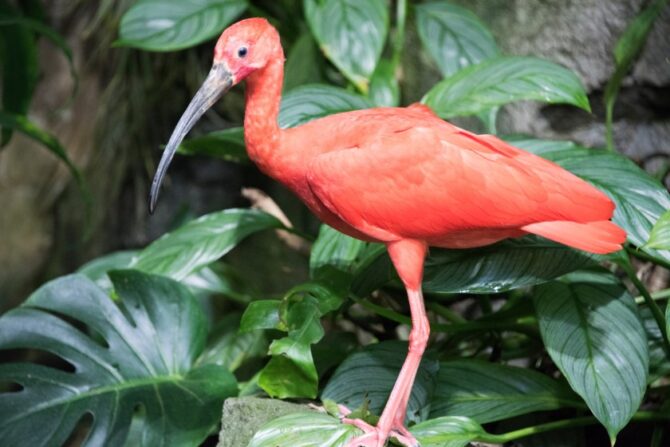
- Scientific Name: Eudocimus ruber
- Range: South America, Caribbean
The scarlet ibis is a national bird of Trinidad and Tobago and is quite popular in tropical South America.
Just as the name states, the scarlet ibis has colored a bright scarlet which makes it stand out amongst ibis species.
Its other name is guará. The scarlet ibis is protected throughout the world.
Its feathers are predominantly scarlet, and the only side of its body not colored scarlet is the wingtip which is a rich black.
Its bill is also long and black. The scarlet ibis tends to walk on foot or glide through the water, but it flies a lot too.
4. Shining Green Hummingbird

- Scientific Name: Chrysonia goudoti
- Range: Colombia, Venezuela
The shining green hummingbird is a native of Colombia and Venezuela. Similar to other hummingbirds, it is small and makes a humming sound when flying, hence the name.
As its name shows, this hummingbird species is green at the upper parts and a shining blue-green underneath.
Not all of its body is green, though. There’s a combination of black within.
The plumage is iridescent, which adds to the attraction. As a tropical bird, it thrives in tropical and subtropical dry forests and dry shrublands.
5. Long-tailed Broadbill
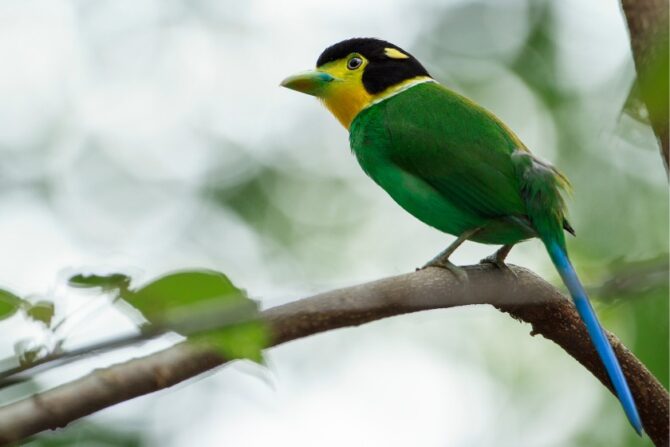
- Scientific Name: Psarisomus dalhousiae
- Range: The Himalayas
The long-tailed broadbill is a native of the Himalayas, a mountain range in Asia. Again, the name points to its defining trait, the long tail feathers.
Then there is the color pattern that makes it a viable candidate for our list. You’d find them in countries like India, Nepal, China, Malaysia, and Indonesia.
The broadbill has a yellow throat and face, while its plumage is an overall green with tinges of blue.
The long tail has blue upper parts, but the underside is black. The bill is yellowish green with light edges, and the top of its head is black.
6. Mandarin Duck

- Scientific Name: Aix galericulata
- Range: East Asia
While there’s such an expression as “ugly duckling,” it doesn’t apply to the Mandarin duck.
This bird is very colorful, though the beauty is limited to the males. Females are drab in comparison. The only similarity males have with females is the crest on their heads.
The male mandarin duck has a red bill and a face that combines white with brown and a bluish-green stripe running across the head.
Other physical features of the ornate male include a purple breast, orange feathers, and ruddy flanks.
7. Violet-backed Starling

- Scientific Name: Cinnyricinclus leucogaster
- Range: Africa
The violet-backed starling also goes by the name amethyst starling or plum-colored.
Just like the mandarin duck, the violet-backed starling is sexually dimorphic, and only the male is highly colorful. The best place to find these starlings is up on a tree, as they hardly come down.
The violet-backed starling is iridescent, making it both shiny and beautiful. Its head and back are violet, but the underparts are white. It feeds on seeds, fruits, and arthropods.
8. Rainbow Lorikeet

- Scientific Name: Trichoglossus molucannus
- Range: Australia
The rainbow lorikeet is a native of Australia, but it has been introduced in other countries like New Zealand, Hong Kong, Auckland, and Tasmania.
Just as the name shows, the rainbow lorikeet combines color like the rainbow.
The head is blue, while the nuchal collar is colored yellow. The beak is first black for juveniles but became orange for adults.
The upper parts are colored green, while the chest is orange/yellow. The thighs and rump are green.
9. Crimson Sunbird

- Scientific Name: Aethogypa siparaja
- Range: Southern Asia
The crimson sunbird is a part of the sunbird family, and like all sunbirds, it feeds largely on nectar.
It also feasts on insects, usually when they need to feed young ones. The crimson sunbird is small but flies fast and direct, using its short wings for support.
It sometimes hovers while feeding but is usually known to perch. It is very popular, and one reason is because of its colors.
The crimson sunbird portrays a clear sexual dimorphism, with the males being more colorful.
It has a crimson breast, brown back, a down-curved bill, and a yellow rump. Overall, the f obvious colors you’ll see are red and maroon.
10. European Bee Eater

- Scientific Name: Merops Apiaster
- Range: Europe, Africa, Asia
Though called the European Bee-eater, this bird isn’t limited to Europe. It can also be found in Africa and Asia.
In Africa, it occurs more in the northern and southern regions. Asian individuals live more in the west.
Bee-eaters are known to be colorful, and the European species is not an exception.
The European Bee-eater is colored brown and yellow on the upper parts, but the wings are green, and the beak is black.
There is no strong sexual dimorphism here, as both males and females are alike.
11. Golden-hooded Tanager
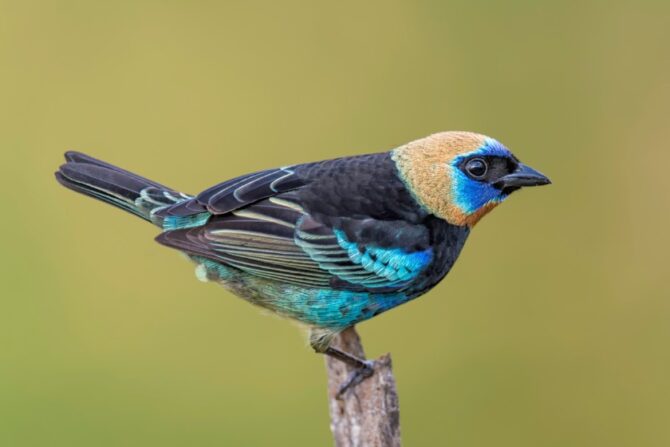
- Scientific Name: Stilpnia larvata
- Range: Mexico, Ecuador
The golden hooded tanager lives in tropical and humid areas, and one way to recognize them in their habitat is to look for birds moving in pairs.
This bird is a native of Southern America, specifically in the southern side of Mexico and western Ecuador.
This is an attractive tanager with a color combination of black, blue, white, and violet.
The upper parts are black, though the shoulders, rump, wings, and tail are colored turquoise. This bird is quite vocal, making a tsit sound.
12. Echo Parakeet

- Scientific Name: Psittacula eques
- Range: Mauritius
The Echo parakeet can be found only in Mauritius, specifically in the Mascarene islands.
Even more, there are no other parrots on the Mascarene islands except the echo parakeet, as others have gone extinct. Sadly, echo itself is classified as Vulnerable by the IUCN.
This parakeet doesn’t combine as many colors as some others on this list, but its bright overall green is colorful.
Its back is dark, and the underside is yellow, diverging from the dominant green. The iris follows the yellow color of the underside. Females are males are similar, except that the females are somewhat smaller.
13. Common Starling
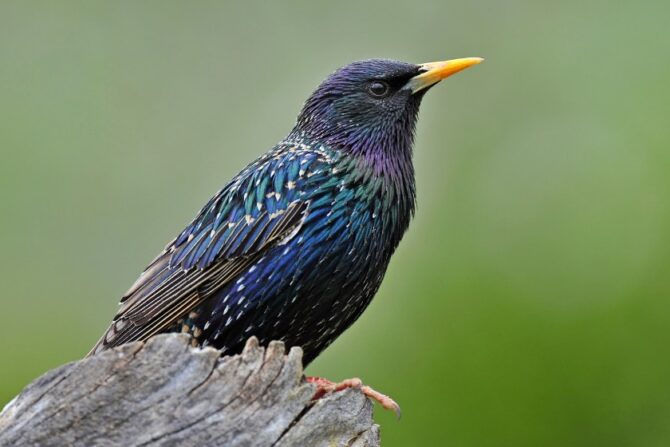
- Scientific Name: Sturnus vulgaris
- Range: Europe, Asia
The common starling is simply called the starling and can also go by the name European starling.
It is well known for its vocal nature, and it is easy to pick up its presence in its habitat.
The common starling is a native of Europe and Asia, spread out in different countries like Morocco, Egypt, China, Nepal, Syria, Iraq, and Israel.
The common starling is not predominantly bright, but it is colorful nonetheless.
Its black is iridescent, combined with some purple and green. During the winter period, you’ll also find some white.
14. Rose Robin

- Scientific Name: Petroica rosea
- Range: Australia
The rose robin is as attractive as its name, especially with the lovely colors on the chest.
It isn’t the only colorful robin in the world, but its chest makes it a viable candidate for this list. It is sexually dimorphic, with the males being more colorful than the females.
Its head, eyes, back, and wings are dark grey, but the belly is pink and green. Females are simply dark grey all over.
15. Little Blue Heron
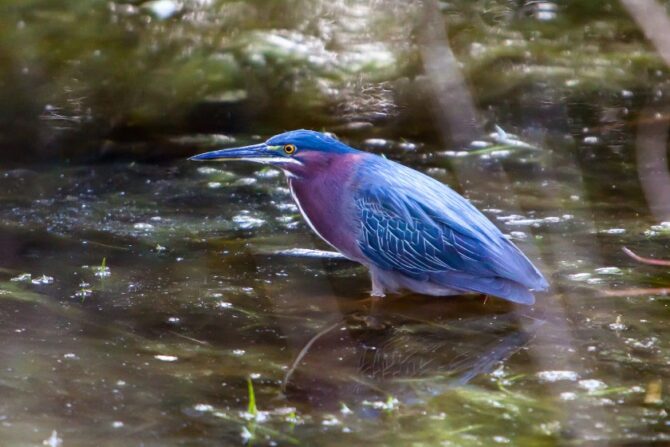
- Scientific Name: Egretta caerulea
- Range: Americas
The little blue heron is of the genus Egretta, and it is a native of the Americas. You can find it in countries like Mexico, the United States, Colombia, and Peru.
Some individuals have occurred in South Africa, Greenland, and Poland, but that is not their main
The little blue heron doesn’t combine many bright colors, but it is colorful nonetheless. Juveniles have white plumages, but as they grow, the plumage becomes dark blue.
Males and females have the same feather color, but in the breeding season, the head of the male turns red. Eyes are always yellow, and the bills are two-toned.
16. Common Flameback
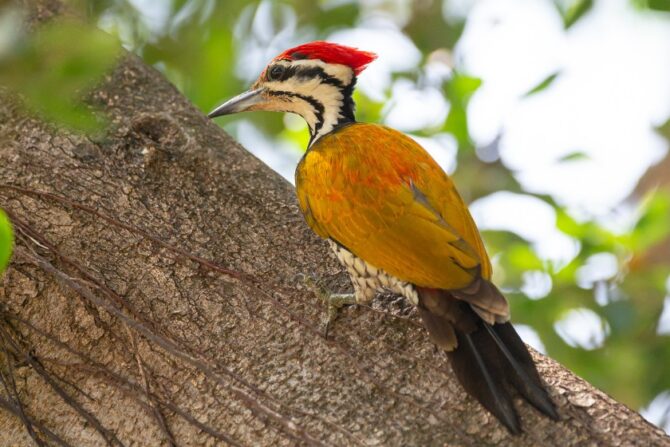
- Scientific Name: Dinopium Javanese
- Range: Southeast Asia
The common flameback is also called the common goldenback, and it is a colorful woodpecker bird that lives in Southeast Asia.
You can find them in different habitats like open forests, mangroves, and scrubs.
Because of their reclusive nature, they are hardly found in urban areas. You’d have to find them in their habitats.
Woodpeckers tend to have lovely colors, and the common flameback is not an exception.
Males have a bright red crest, while females come with a black-and-white crest. Its back is colored golden—hence the name—while the underparts are similar to the female’s crest.
Both sexes have black-and-white faces. As a shy bird, it hardly makes noise. It also doesn’t drum on wood, a surprising trait given that it is a woodpecker.
17. Red-crested Turaco
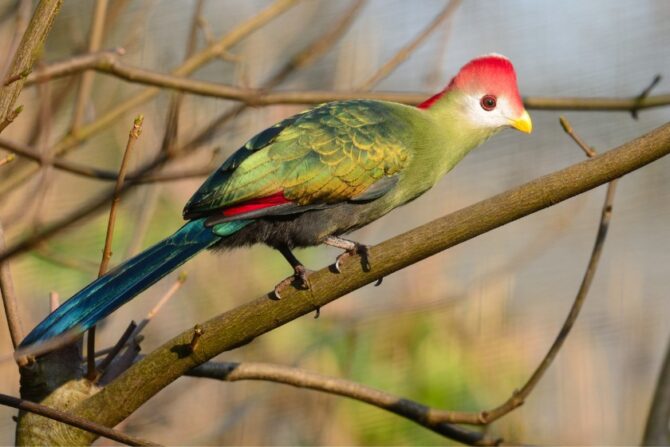
- Scientific Name: Tauraco erythrolophus
- Range: Angola
The red-crested turaco refers to a group of African birds of the clade Otidimorphae, all of which live in western Angola.
It inhabits the Miombo woodlands and forests of its range. Its color combination is similar to that of a watermelon, and unsurprisingly the red-crested turaco is a frugivore.
Its main identifying feature is the red crest sitting on the head with a whitish face and green plumage.
The upper parts are darker than the underneath, which is a lighter shade. The red-crested turaco moves in flocks of 30 or sometimes in pairs.
18. Common Kingfisher
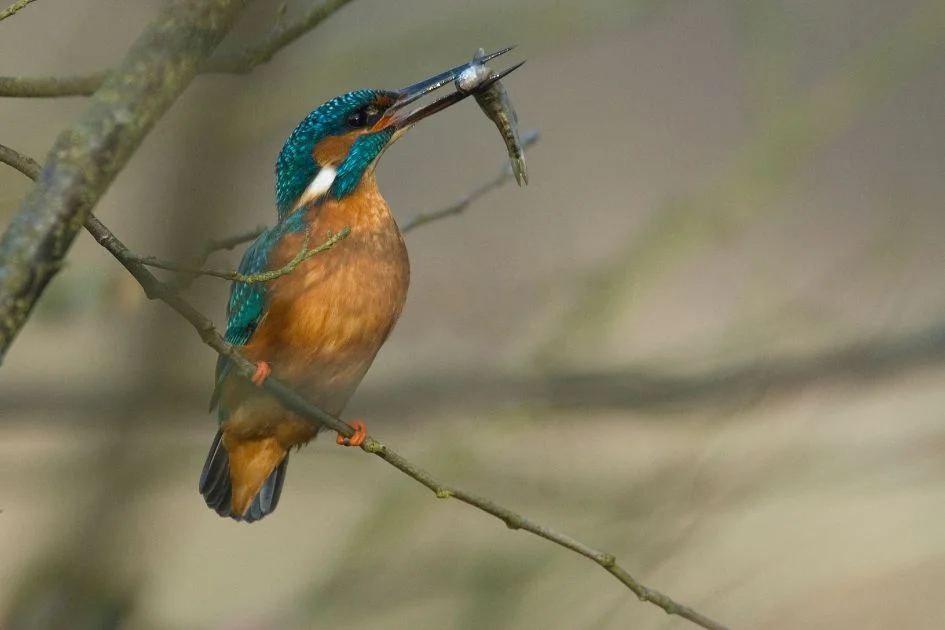
- Scientific Name: Alcedo atthis
- Range: Europe, Asia, Africa
The common kingfisher is also known as the river kingfisher or the Eurasian kingfisher.
It occurs in Europe, Asia, and Africa, and it is known to migrate during the winter. The male and female are both colorful, but the combinations aren’t the same.
The male common kingfisher has blue upper parts, an orange belly, and streaks of white close to its head.
Females are usually green on the wings with orange underneath. Other physical features are what you’d expect from a kingfisher, from the short tail to the long bill and large head.
19. Temminck’s Tragopan

- Scientific Name: Tragopan temminckii
- Range: Asia
The Temminck’s tragopan stays across the Indian mountains, as well as in China and Myanmar.
The bird is named after the Dutch naturalist Coenradd Jacob Temminck. The adult male is more glamorous than the female, who is drab in comparison.
The male has a blue face, red and orange spotted plumage, a black bill, and pink legs.
Females have a predominantly brown spotted color, even on the face. Temminck’s tragopan is classified as least concern by the IUCN.
20. Gouldian Finch
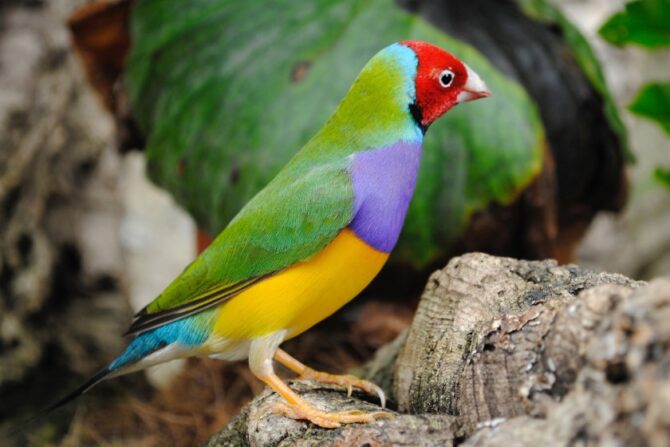
- Scientific Name: Chloebia gouldiae
- Range: Australia
The Gouldian finch also goes by the name rainbow finch, the Lady Gouldian finch, and the Gould’s finch.
It is a native of Australia, though it can be found in different parts of the world due to exportation.
As the alternative name shows, the finch is a combination of bright colors similar to a rainbow.
Both males and females are colorful, but the males tend to be more so. The heads may come in three colors, red, black, or yellow.
The plumage combines violet, yellow, green, and sky blue. On the plumage, there are also markings which could be green, yellow, red, or black.
Final Thoughts
These beautiful and colorful tropical birds are part of nature’s beauties, and you can explore them with our options.
These colorful birds have even been the subject of numerous research, and there are far more species than we have on our list.
Next up…
- These Purple Bird Species are a Sight to Behold.
- Discover these Elegant White Birds From Around the World.
- Here are the Most Beautiful Birds in the World and Where to Find Them.
References & Notes
- Cooney, C. R., He, Y., et al. (2022). Latitudinal gradients in avian colourfulness. Nature Ecology & Evolution, 6(5), 622-629.
